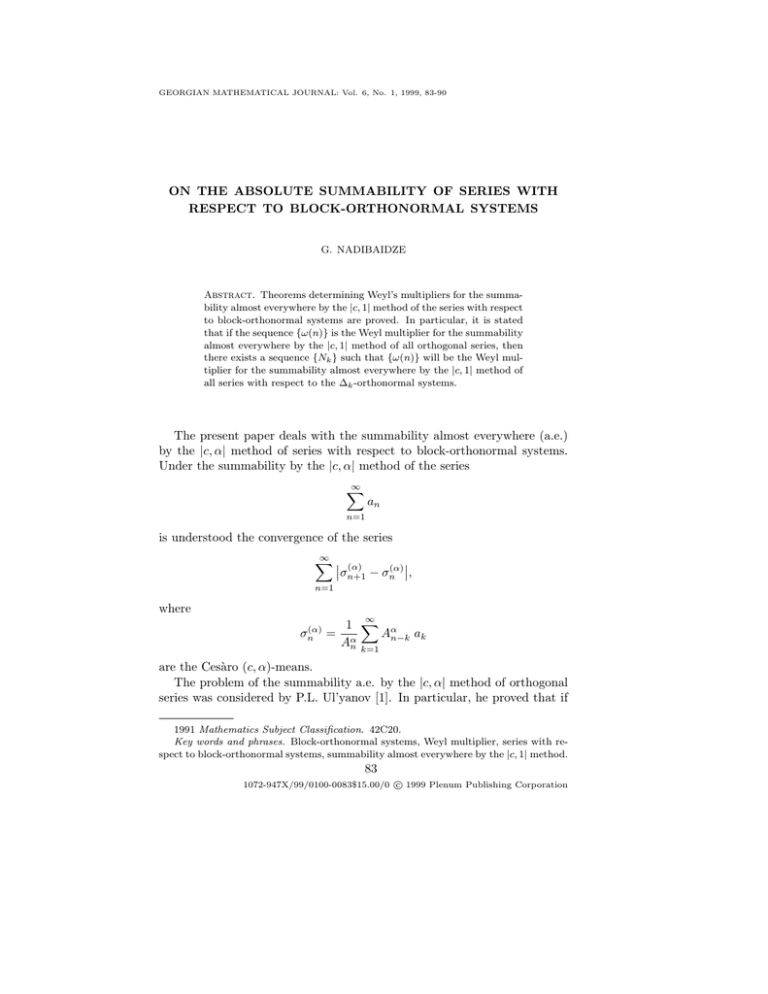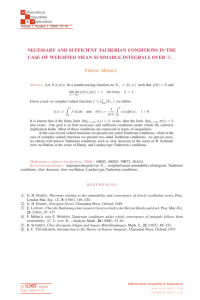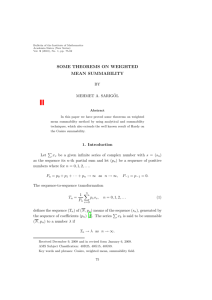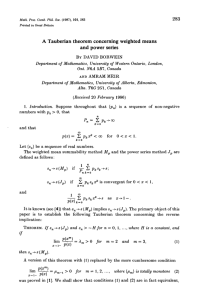ON THE ABSOLUTE SUMMABILITY OF SERIES WITH RESPECT TO BLOCK-ORTHONORMAL SYSTEMS
advertisement

GEORGIAN MATHEMATICAL JOURNAL: Vol. 6, No. 1, 1999, 83-90
ON THE ABSOLUTE SUMMABILITY OF SERIES WITH
RESPECT TO BLOCK-ORTHONORMAL SYSTEMS
G. NADIBAIDZE
Abstract. Theorems determining Weyl’s multipliers for the summability almost everywhere by the |c, 1| method of the series with respect
to block-orthonormal systems are proved. In particular, it is stated
that if the sequence {ω(n)} is the Weyl multiplier for the summability
almost everywhere by the |c, 1| method of all orthogonal series, then
there exists a sequence {Nk } such that {ω(n)} will be the Weyl multiplier for the summability almost everywhere by the |c, 1| method of
all series with respect to the ∆k -orthonormal systems.
The present paper deals with the summability almost everywhere (a.e.)
by the |c, α| method of series with respect to block-orthonormal systems.
Under the summability by the |c, α| method of the series
∞
X
an
n=1
is understood the convergence of the series
∞
X
(α)
(α)
σ
,
n+1 − σn
n=1
where
σn(α)
∞
1 X α
= α
An−k ak
An
k=1
are the Cesàro (c, α)-means.
The problem of the summability a.e. by the |c, α| method of orthogonal
series was considered by P.L. Ul’yanov [1]. In particular, he proved that if
1991 Mathematics Subject Classification. 42C20.
Key words and phrases. Block-orthonormal systems, Weyl multiplier, series with respect to block-orthonormal systems, summability almost everywhere by the |c, 1| method.
83
c 1999 Plenum Publishing Corporation
1072-947X/99/0100-0083$15.00/0
84
G. NADIBAIDZE
the condition
∞
X
1
< ∞,
n ω(n)
n=1
(1)
is fulfilled for a positive nondecreasing sequence {ω(n)}, then the convergence of the series
∞
X
an2 ω(n)
n=1
guarantees the summability a.e. on (0, 1) by the |c, α| method (α > 12 ) of
the series
∞
X
an ϕn (x)
(2)
n=1
for every orthonormal system from L2 (0, 1).
If however
∞
X
1
= ∞,
n ω(n)
n=1
then there exists an even function f (x) ∈ ∩ Lp [0, 2π] such that its Fourier
p≥1
series
f (x) ∼
∞
X
cn cos nx
n=1
converges a.e. on [0, 2π] and for every fixed α > 0 is not |c, α| summable
a.e. on [0, 2π] though
∞
X
c2n ω(n) < ∞.
n=1
Definition 1 (see [2]). Let {Nk } be an increasing sequence of natural
numbers, ∆k = (Nk , Nk+1 ], k = 1, 2, . . . , and {ϕn } be a system of functions
from L2 (0, 1). The system {ϕn } will be called a ∆k -orthonormal system
(∆k -ONS) if:
(1) kϕn k2 = 1, n = 1, 2, . . . ;
(2) (ϕi , ϕj ) = 0 for i, j ∈ ∆k , i 6= j, k ≥ 1.
Definition 2 (see [1]). A positive nondecreasing sequence {ω(n)} will
be called the Weyl multiplier for the summability a.e. of series with respect
to the ∆k -ONS {ϕn } if the condition
∞
X
n=1
a2n ω(n) < ∞
(3)
ON THE ABSOLUTE SUMMABILITY OF SERIES
85
guarantees the summability a.e. by the |c, α| method of the corresponding
series (2).
Below we shall quote the theorem showing that if the sequence {ω(n)}
is the Weyl multiplier for the summability a.e. by the |c, 1| method of all
orthogonal series (2), then it will be the Weyl multiplier for the summability
a.e. by the |c, 1| method of all series (2) with respect to the ∆k -ONS for
the increasing sequence of natural numbers {Nk }.
Theorem 1. If a positive nondecreasing sequence {ω(n)} is the Weyl
multiplier for the summability a.e. by the |c, 1| method of all orthonormal
series (2), then there exists an increasing sequence of natural numbers {Nk }
such that {ω(n)} is the Weyl multiplier for the summability a.e. by the |c, 1|
method of all series (2) with respect to the ∆k = (Nk , Nk+1 ]-ONS.
Proof. We prove this theorem by the Wang–Ul’yanov’s scheme (see [1])
modifying it accordingly. Let the positive nondecreasing sequence {ω(n)}
be the Weyl multiplier for the summability a.e. by the |c, 1| method of all
orthogonal series (2). Then condition (1) is fulfilled.
As is known (see [1]), for the positive nondecreasing on [n0 , +∞) function
ω(x) the series
∞
X
m=n0
∞
X
1
and
m ω(m)
m=n20
1
√
m ω( m)
converge or diverge simultaneously. Therefore, taking into account (1), we
have
∞
X
1
√
< ∞.
4
n
ω(
n)
n=1
Then
∞
X
R(n)
√ < ∞,
n ω( 4 n)
n=1
where
P
∞
R(n) = k=2
∞
P
1√
4
k ω( k)
k=n+1
(4)
21
1√
4
k ω( k)
12 .
Obviously, R(1) = 1, R(n) < R(n + 1) and limn→∞ R(n) = +∞.
Define the sequence k(n) by the recursion formula
(
if R(n + 1) ≥ k(n) + 1,
k(n) + 1
k(1) = 0, k(n + 1) =
n ≥ 1.
k(n)
if R(n + 1) < k(n) + 1,
86
G. NADIBAIDZE
Thus we obtain the nondecreasing sequence of nonnegative integers for
which
k(n) ≤ R(n),
n = 1, 2, . . . .
(5)
Note that for the sequence k(n) there exists an increasing sequence of natural numbers {Nk } (it is assumed that N0 = 0) which is defined by the
formula
k(n) = max{k : Nk < n}.
Then, taking into account (4) and (5), we find that
∞
X
k(n)
√ < ∞.
n ω( 4 n)
n=1
(6)
Let {ϕn } be a block-orthonormal system with ∆k = (Nk , Nk+1 ] and
condition (3) be fulfilled. Then for the corresponding series (2) we have
σn (x) − σn−1 (x) =
∞
X
1
ai (i − 1) ϕi (x), n ≥ 2.
n(n − 1) i=1
Denoting by c the absolute positive constants which, generally speaking,
may have different values in different inequalities and using (6), we find
that
∞ Z1
∞ Z1
1
X
X
σn (x) − σn−1 (x)dx ≤
σn (x) − σn−1 (x)2 dx 2 ≤
n=2 0
n=2
≤c
∞
X
1
2
n
n=2
Z1
0
0
n
X
2 21
ai (i − 1)ϕi (x) dx
≤
i=1
Z1 NX
k(n)
∞
2 Z1
X
1
≤c
ai (i−1)ϕi (x) +
2
n
n=1
i=1
0
0
≤c
Nk(n)
X
1
a2i i2 +
k(n)
2
n
n=1
i=1
∞
X
n
X
i=Nk(n) +1
n
X
i=Nk(n) +1
2 12
ai (i−1)ϕi (x) dx ≤
a2i i2
12
≤
4
[√
n]
∞ p
∞
n
1
X
X
X
k(n) X 2 2 12
1
2 2 2
c
i ai
a
≤c
≤
+
k(n)
i
i
n2
n2
n=1
n=1
i=1
i=1
√ √ 1
X
n
∞ p
X
1
k(n)( n 4 n) 2
2 2 2
+
+
i ai
≤c
n2
√
4
n=1
i=[
n]+1
ON THE ABSOLUTE SUMMABILITY OF SERIES
≤
X
∞
n=1
√ 1
∞ p
X
k(n) nω( 4 n)) 2
+
√
n2 nω( 4 n)) 12
n=1
1
9
n8
+
√
∞
X
ω( 4 n)
n3
n=1
n
X
i=[
n
X
i=[
√
4
n]+1
√
4
i2 ai2
n]+1
i2 ai2
12
≤
k(n) 12
√
kω( 4 n)
n=1
∞
12 X
87
≤
∞
∞
∞
12
X
X
12
1 X 2 2
2
c
ω(i)
≤c+c
≤
+
c
a
< ∞,
i
a
ω(i)
i
i
n3 i=1
n=1
i=1
whence by Levy’s theorem
∞
X
σn (x) − σn−1 (x) < ∞ a.e. on (0, 1).
n=2
The theorem below makes it possible to determine the Weyl multipliers
for the summability a.e. of the series (2) with respect to the ∆k -ONS for
regularly increasing sequences {Nk }.
Theorem 2. Let an increasing sequence of natural numbers {Nk } be
given, for which the condition
∞
n
X
1
(n → ∞)
=
O
Nk2
Nn2
(7)
k=n
is fulfilled, and let
k(n) = max{k : Nk < n}.
If for the positive nondecreasing sequence {ω(n)} condition (1) is fulfilled,
then for every ∆k -ONS {ϕn } the condition
∞
X
n=1
a2n ω(n) k(n) < ∞
(8)
guarantees the summability a.e. by the |c, 1| method of the corresponding
series (2).
Proof. Let conditions (1), (7) and (8) be fulfilled. Then for the corresponding series (2) we have
∞ Z1
∞ Z1
1
X
X
σn (x) − σn−1 (x)dx ≤
σn (x) − σn−1 (x)2 dx 2 ≤
n=2 0
n=2
0
Z1 NX
Z1
k(n)
2
1
≤c
ai (i−1)ϕi (x) dx+
2
n
n=1
i=1
∞
X
0
0
n
X
i=Nk(n) +1
2 21
ai (i−1)ϕi (x) dx ≤
88
G. NADIBAIDZE
√
4
[X
n]
∞
∞ p
∞
21
1
X
X
X
k(n)
1
2 2
2 2 2
≤c
k(n)
a
≤
c
+
i
i
a
i
i
n2
n2
n=1
n=1
i=1
i=n
X
3
∞ p
n
X
1
k(n)n 8
2 2 2
+
+
≤c
i ai
n2
√
4
n=1
i=[ n]+1
√ 1
n
∞ p
1
X
k(n) (nω( 4 n)) 2 X
2 2 2
i
≤
+
a
√
i
n2 (nω( 4 n)) 12
√
4
n=1
i=[
n]+1
∞
∞
∞
21 X
X
12
1
k(n) X 2 2
√
≤c+c
i
ω(i)
≤
a
i
n3 i=1
nω( 4 n)
n=1
n=1
≤c+c
∞
X
i2 a2i ω(i)
i=1
∞
X
k(n) 12
i=1
n3
=
1
Nk(i)+1
X
Nj+1
∞
∞
X k(i)
X 1 2
X
2 2
+
j
=c+c
i ai ω(i)
≤
n3
n3
n=i
i=1
j=k(i)+1 n=Nj +1
X
∞
∞
X
k(i)
1
2 2
≤c+c
i ai ω(i)
+
(k(i)
+
1)
+
2
3
i
n
i=1
n=Nk(i)+1 +1
+
∞
X
j=k(i)+1
1
Nj2
12
∞
X
12
≤c+c
< ∞,
i2 ai2 ω(i)k(i)
i=1
whence by Levy’s theorem
∞
X
σn (x) − σn−1 (x) < ∞ a.e. on (0, 1).
n=2
Remark 1. In Theorem 2, the Weyl multipliers defined by conditions (1)
and (8) can be assumed to be exact on the set of sequences {Nk } with
condition (7) in the sense that if condition (1) is violated, then one can
construct a sequence {Nk } for which condition (7) is fulfilled and also there
exists a trigonometric series
∞
X
bn cos nx,
n=1
which is nonsummable by the |c, α| method for almost all x ∈ [0, 2π] (for
every fixed α > 0) though
∞
X
n=1
b2n ω(n) k(n) < ∞.
ON THE ABSOLUTE SUMMABILITY OF SERIES
89
Indeed, let the condition
∞
X
1
=∞
n ω(n)
n=1
be fulfilled for the sequence {ω(n)}.
We construct an increasing sequence of natural numbers {Nk } in such a
way that the condition
k=O
Nk
X
1 β
1
, 0<β≤ ,
n ω(n)
2
n=1
be fulfilled and the sequence Nkk be increasing.
Clearly, condition (7) is fulfilled (see [3], Remark 2).
Take
k
X
1
sk =
, k = 1, 2, . . . ,
n
ω(n)
n=1
and
1
cm = √
1
m ω(m) (sm )β+ 2
Then for arbitrary εm = ±1 we have
∞
X
(εm cm )2 ω(m)k(m) =
m=1
=
∞
X
Nk+1
X
k=0 m=Nk +1
≤c
∞
X
∞
X
k(m)
=
2β+1
m
ω(m)(s
m)
m=1
∞
X
k(m)
≤c
2β+1
m ω(m)(sm )
Nk+1
X
k=0 m=Nk +1
Nk+1
X
m = 1, 2, . . . .
k=0 m=Nk +1
(sNk )β
≤
m ω(m)(sm )2β+1
∞
X
1
1
≤
c
< ∞.
1+β
m ω(m)(sm )1+β
m
ω(m)(s
m)
m=1
On the other hand,
∞
X
n=0
n+1
2X
m=2n +1
c2m
21
≥
≥
∞
X
n=0
∞
X
n+1
2X
1
2 (s )1+2β
m(ω(m))
m
m=2n +1
12
≥
1
1
= ∞.
n
2 n=1 ω(2 )(s2n ) 21 +β
Therefore by Billard’s theorem [1], for almost all choices of εk = ±1 the
series
∞
X
εm cm cos mx
m=1
90
G. NADIBAIDZE
is |c, α|-nonsummable (α > 0) at almost every point x ∈ [0, 2π] though
∞
X
n=1
where bn = εn cn .
b2n ω(n) k(n) < ∞,
Remark 2. The above theorems remain also valid for |c, α| methods with
cα > 21 .
References
1. P. L. Ul’yanov, Solved and unsolved problems of the theory of trigonometric and orthogonal series. (Russian) Uspekhi Mat. Nauk 19(1964), No.
1, 3–69.
2. V. F. Gaposhkin, Series of block-orthogonal and block-independent
systems. (Russian) Izv. Vyssh. Uchebn. Zaved. Mat. 1990, No. 5, 12–18;
English translation: Soviet Math. (Iz. VUZ), 34(1990), No. 5, 13–20.
3. G. G. Nadibaidze, On some problems connected with series with
respect to ∆k -ONS. Bull. Acad. Sci. Georgia 144(1991), No. 2, 233–236.
(Received 15.05.1997)
Author’s address:
J. Javakhishvili Tbilisi State University
Faculty of Mechanics and Mathematics
2, University St., Tbilisi 380043
Georgia






